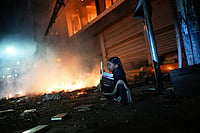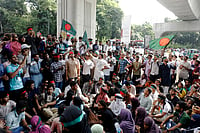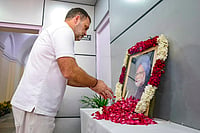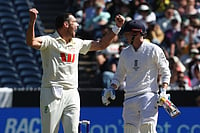It's the empire revisited—and reversed. Among the some 2.5 million-strong immigrant population of Britain, there are now about one million Indians for whom the island is home. Some of them, including a clutch of industrialists and curry-and-pickle barons, have done exceedingly well for themselves; others eke out uneventful lives. But putting down your roots in a foreign land is not without its emotional perils. For it leads to a kind of double homesickness, straddling two homes, always longing and never belonging.
Back in Delhi, Parthiv Shah's digital montage prints of pictures and words of 34 Indians living in Britain echo the same sentiment. (The show runs at the capital's British Council till December 2) It's an unusual exhibition from the 38-year-old Delhi-based photographer-graphic designer-documentary film-maker. ‘Figures, Facts, Feelings', as Shah christens his work, was born out of a six-month-long Charles Wallace scholarship at the London-based School of Oriental and African Studies (soas) two years ago. His methodology was simple, if quirky: pick 34 individuals of Indian origin from different parts of England and let them decide the "frame, situation, time, dress and ambience" for their pictures. Then he gave them a simple, 21-point questionnaire listing, among other things, their favourite films, food, books and music and problems in India. The result is a digital montage of pictures of ordinary people saying ordinary things. "It's a dialogue between the photographed and the photographer and the reader/viewer," says Shah.
The approach does work at one level, but then doesn't at another. The pictures and words faithfully deglamourise the much-idolised nri archetype. In their sanitised, somewhat sad looking, carpeted, look-alike wallpapered drawing rooms with big-screen TV's and heaters, most of Shah's subjects look a tad lost and seem to be pining for imaginary homelands. But sometimes the photo-verite point seems to have been overstretched: some of the subjects have even been shot with instamatic cameras, giving them those annoying "red eyes". This does not make for pictures with a feeling. But it's an interesting exercise nonetheless. The subjects choose typical and comfortable lairs for their pictures: the drawing room, the bedroom, the work-station, kitchen, even the loo. Only three among all the people photographed venture outside their homes to pose with their flashy cars or in the background of the grey London skyline.
There are not many surprises either: cheery secondary school student Philpa Parmar, who lists Prades (sic) and Titanic as her favourite films, poses in her bedroom with the wall plastered with Leonardo DiCaprio and boyband posters. And careworker Jarnail Singh Rana, who puts down his native place as ‘Sarhala (Khalistan)' poses proudly in a jacket in front of a garish film poster that tells the story of Guru Gobind Singh. Others, like academic Sunil Khilnani, look self-conscious, even after choosing the frame and location: when he steps out of his office to pose—as he likes "nature and fresh air"—he becomes pensive and shy.
The highlights are two delightfully wicked frames: senior lecturer Gurcharan is delightfully irreverent as she poses in her blue-tiled loo with white doors opening out to tomato-red stairway walls. She selected this frame because "sitting in the loo I can study and shit away." And there's a grinning surgeon Chandra Rathore—who says his education is still incomplete after seven medical degrees under his belt—posing with a bottle of white wine and a piss-boy corkscrew in his unkempt kitchen. He chose this frame to "misinform and misrepresent". But the choicest pick in terms of pictures has to be the photographer Sunil Janah in his darkroom, rummaging through prints. "He doesn't go into his darkroom very often these days because of his failing eyesight," says Shah. "But he decided to pose there because he says he felt most comfortable there."
It's the reactions of Shah's subjects on the questionnaire that are rather predictable. Their favourite films range from Bicycle Thief to Apur Sansar, Shor and Titanic. Their favourite food is no surprise either: kidney beans, Thai and some pasta seem to be the only culinary adventures outside roti and curry. But young Parmar, who has never visited India and thinks it is "colourful and lively", sums it all up when asked about her cultural dilemma. It's about "finding a middle way between being an Indian and living in Britain", she says. Truly a touching statement on the predicament of the Indian diaspora.
Shadowline Homes
A show that explores the lives of Indian immigrants in Britain

Shadowline Homes
Shadowline Homes
Published At:
MOST POPULAR
WATCH
MORE FROM THE AUTHOR
×




















